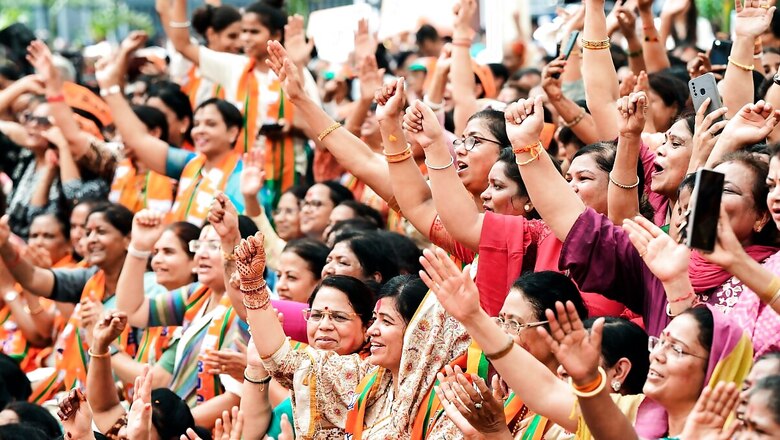
views
With the Lok Sabha elections inching towards completion, an analysis of women candidates in the fray shows that yet again political parties have just paid lip service on women representation in Parliament despite the historic women’s reservation bill passed last year. The bill provides for 33% reservation for women in the Lok Sabha and Legislative Assemblies but will most likely come into effect only after 2029. None of the major parties attempted to set healthy precedents this time.
On an average, every woman candidate in this election has had to battle 10 male candidates. The statistics hold true for all major national parties in the fray.
Around 8,360 candidates were in the fray for the Lok Sabha elections, including the upcoming seventh and final phase. Just 801 of these are women, while 7,557 are men, analysis of the data from the Election Commission of India shows. This is the highest number of women in the fray since the first Lok Sabha elections in 1951-52. But in proportion to total candidates, it is not the best.

While national parties have been shying away from fielding women, the regional parties have performed better, the data from the EC and the Association for Democratic Reforms (ADR) shows.
As many as 278 women are fighting the elections as Independent candidates. There were a total of 3,903 Independent candidates in the fray.
Apna Dal (Sonelal), a party based in Uttar Pradesh, has fielded two candidates, both women. Apart from party president Anupriya Patel, contesting for a third term from Mirzapur, it has fielded Rinki Kol from Robertsganj in the state.
Tamil Nadu’s Naam Tamilar Katchi has fielded 40 candidates and half of these are women.
Lok Janshakti Party (Ram Vilas) and Ajit Pawar’s Nationalist Congress Party (NCP) fielded five candidates each and an equal number of women at two (40%).
From Jharkhand Mukti Morcha, two women (33%) were in the fray out of a total of six candidates. Naveen Patnaik’s Biju Janata Dal (BJD) has fielded 33% women – seven among 21 candidates.
Another Tamil Nadu-based party, the Pattali Makkal Katchi, fielded total of 10 candidates, of whom three are women (30%).
In Lalu Prasad Yadav’s Rashtriya Janata Dal (RJD), women representation stood at 29%, seven women among 24 candidates. Mamata Banerjee’s All India Trinamool Congress has 25% women candidates – 12 women among 48 leaders in the fray.
In Akhilesh Yadav’s Samajwadi Party, out of 71 candidates, 14 are women (20%).
YS Jagan Mohan Reddy’s Andhra Pradesh-based Yuvajana Sramika Rythu Congress Party (YSRCP) has fielded four women among 25 candidates (16%).
How Do National Parties Score?
Out of the 441 candidates fielded by the BJP, just 70 were women (16%). With just 41 women out of 327 candidates, women representation in the Congress was 13%. In Bahujan Samaj Party, this share was just 5%, while the Aam Aadmi Party has fielded zero women candidates. In the Communist Party of India (Marxist), with just seven women candidates, the women representation stood at 13%.
After the Women’s Reservation Bill was passed in September 2023, parties across the political spectrum had made big pitches of women empowerment and the need for reserving seats for women candidates.
The history of demand for women’s reservation is long. The first time such a bill was introduced was 1996. Since then, parties had off and on raised their voices in favour of 33% reservation for women. However, they failed this time in giving women their due share in decision-making or ticket distribution.
Despite tall promises, yet again, almost all the major parties in the country have failed in ensuring decent space for women in Lok Sabha battle.
The statistics show that unless women’s reservation in Lok Sabha and Assemblies is binding in law, none of the parties will step up willingly. But there is no roadmap yet on which election the bill will come into effect from.
Explore in-depth coverage of Lok Sabha Election 2024 Voter Turnout, Upcoming Phase, Results Date, Exit Poll And Much More At News18 Website


















Comments
0 comment